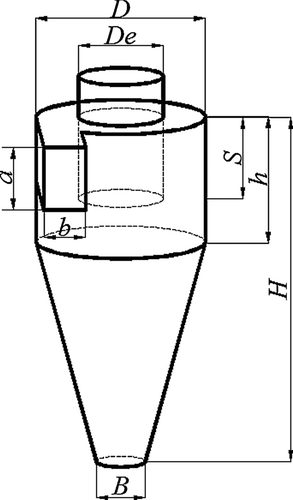Abstract
To predict the cyclone separation efficiency, a semi-empirical dimensionless multivariate logistic model is developed by stepwise multiple regression based on dimensional analysis. The model can be expressed as a simple explicit function of characterized dimensionless numbers for cyclone geometries, the dimensionless number for gas flow called Reynolds number and the dimensionless number for particle dynamics called Stokes number. The model coefficients are regressed according to the experimental data reported by CitationIozia and Leith (1990), which includes the effects of cyclone geometrical parameters, gas-particle physical parameters and operating parameters. The result indicates there is an agreement between the experimental data and model prediction with the mean squared error (MSE) of 0.62 and the efficient of determination (COD) of 0.90. Further, by the comparison with the additional experimental data as well as several popular theoretical models, it is found that although the present model can not reveal detailed mechanism and process of the gas-particle flow and separation in cyclones, it still is demonstrated to be useful and applicable to predict the cyclone separation efficiency.
NOMENCLATURE
| a(m) | = |
cyclone inlet height |
| b(m) | = |
cyclone inlet width |
| B(m) | = |
particle outlet diameter |
| Cc | = |
Cunningham correction factor |
| dp (m) | = |
particle aerodynamic diameter |
| D(m) | = |
cyclone body diameter |
| De (m) | = |
cyclone gas outlet diameter |
| Di (m) | = |
cyclone inlet equivalent diameter |
| Den | = |
gas-particle density ratio |
| E 2 | = |
mean squared error (MSE) |
| E 2 η | = |
mean squared error for efficiency |
| Fr | = |
Froude number |
| g(m/s2) | = |
acceleration of gravity |
| h(m) | = |
cyclone cylinder height |
| H(m) | = |
cyclone height |
| R 2 | = |
coefficient of determination (COD) |
| Re | = |
Reynolds number |
| Rei | = |
Reynolds number for cyclone inlet |
| S(m) | = |
cyclone gas outlet tube length |
| Stk | = |
Reynolds number |
| Stki | = |
Reynolds number for cyclone inlet |
| vi (m/s) | = |
gas velocity at cyclone inlet |
| x | = |
independent variable |
| X | = |
predictor variables matrix |
| y | = |
dependent variable |
| Y | = |
response variable |
|
| = |
predicted response variable |
Greek letters
| α | = |
partial regression coefficient |
| η | = |
cyclone separation efficiency |
|
| = |
predicted cyclone separation efficiency |
| μ(Pa.s) | = |
gas dynamic viscosity |
| ρ g (kg/m3) | = |
gas density |
| ρ p (kg/m3) | = |
particle density |
Subscripts
| g | = |
gas |
| i | = |
cyclone inlet |
| p | = |
particle |
1. Introduction
Cyclone separators are widely used in the field of air pollution control and gas-solid separation for aerosol sampling and industrial applications. With the advantages of relative simplicity to fabricate, low cost to operate and good adaptability to extremely harsh conditions, cyclone separators have become one of the most important particle removal devices which are preferably utilized in both engineering and process operation.
In order to describe the cyclone performance, the gas-particle separation models of cyclone separators are developed by many contributors using different methods with different simplifications and assumptions. These models include the equilibrium-orbit models (CitationLapple 1950; CitationBarth 1956; CitationMuschelknautz and Trefz 1992; Dirgo and Leith 1985a; CitationIozia and Leith 1990), the timed flight models (CitationLeith and Licht 1972; CitationClift et al. 1991), the hybrid models (CitationDietz 1981; CitationMothes and Löffler 1988; CitationLi and Wang 1989; CitationKim and Lee 2001; CitationZhao 2005; CitationJiao and Zheng 2007) and the CFD models (CitationBoysan et al. 1982; CitationZhou and Soo 1990; CitationGriffiths and Boysan 1996).
As a mathematical and physical method, regression analysis based on dimensional analysis (RABDA) was used to predict the cyclone separation performance especially for particle cut diameter since the 1970s (CitationChan and Lippmann 1977; CitationSaltzman and Hochstrasser 1983; CitationIozia and Leith 1989; CitationMoore and McFarland 1990; CitationMoore and McFarland 1993; CitationKuo and Tsai 2001). It differs from the theoretical models listed above which require the detailed understanding for the mechanism and process of gas-particle flow and separation. RABDA establishes the model by correlating the cyclone separation parameter with cyclone geometrical parameters and operating conditions parameters according to the result of dimensional analysis. The model coefficients are determined by multiple linear or nonlinear regressions. Historically, Beeckmans and Kim (1977) developed a quadratic response surface model (RSM) to evaluate the cyclone efficiency. In their model the Reynolds number and Stokes number are included, but the effects of cyclone geometrical parameters are not involved. CitationBüttner (1999) found that the cyclone separation efficiency can be expressed as a S shape function of the group of dimensionless numbers Stk 1/2 i Re 1/3 i (Di /De )2/3. Unfortunately, the specific function expression was not given in his report. Therefore, it is difficult to be directly applied to evaluate cyclone efficiency.
This article is an extension of these earlier works. Firstly, the predictor variables and response variable for cyclone separation performance are determined according to the result of dimensional analysis. On this basis, a multivariate logistic function is proposed to establish the separation model. The experimental data from CitationIozia and Leith (1990) are employed to obtain the model coefficients. In this process, a stepwise multiple regression technique (SMR) is used. Finally, the additional experimental data as well as other popular theoretical models are compared to demonstrate the utility of this model in predicting cyclone separation performance.
2. Model
shows the schematic diagram of a typical cyclone separator with eight basic characterizing dimensions. Usually, the separation efficiency in a cyclone separator depends on a series of cyclone configuration parameters, gas-particle physical parameters and operating parameters (CitationOvercamp and Scarlett 1993; CitationHoffmann and Stein 2007). Considering the following assumptions: steady state incompressible viscous flow for gas phase flow, low particle load which has not effect on gas flow pattern and only gravity force as field force, the cyclone separation efficiency can be written in detail as
To theoretically develop the function relationship in Equation (Equation1), the dimensional analysis technique is used in the present work. Dimensional analysis is regarded as a simple and effective method to predict the performance of geometrically similar cyclones. According to the result by the dimensional analysis technique combined with experimental and theoretical results, the dimensional variables in Equation (Equation1) can be combined as the governing dimensionless variables also called dimensionless number. It becomes as:
Stk is the dimensionless numbers for particle dynamics which is named the Stokes number and can be defined as:
Den is the density number which can be defined as:
In Equation (Equation2), the Froude number Fr describes the influence of gravity on the flow pattern and the Den represents gas and particle density ratio. It is found that they did not play an important role in determining the cyclone separation performance (CitationMoore and McFarland 1990; CitationOvercamp and Scarlett 1993). Therefore, they can be neglected. In addition, the cyclone inlet and outlet dimensional parameters are usually grouped in the form of ab/D 2 e in many cyclone performance models. With these simplifications, Equation (Equation2) can be finally expressed as:
It is indicated that the cyclone separation efficiency is mainly related to the dimensionless geometrical parameters, the Stokes number, and Reynolds number.
In order to mathematically describe the relationship between the independent variables and dependent variable in Equation (Equation7), a logistic function is employed to model the function F:
To obtain the value of coefficient α0 to α7 in Equation (Equation9) more easily through the regression analysis, Equation (Equation8) is transformed using the linearization method by taking the natural logarithm of both sides. As a result, it becomes
It is should be noted that, due to the higher sensitivity of the left side of the Equation (Equation11) ln[η/(1−η)] to η close to extreme value 0 and 1, the fitting method gives more weight to data with η near the extremes.
3. Method
3.1. Dataset
The 11 group of experimental data with 99 samples obtained from CitationIozia and Leith (1990) are used in the present work to establish the cyclone performance model. These experimental data, as shown in , cover the different cyclone dimension ratios and the wide operating conditions. Specifically, the cyclone dimensional ratio De /D, a/D, B/D, S/D, H/D, and H/D are in the range of 0.3–0.7, 0.25–0.75, 0.1–0.3, 0.25–0.75, 3.0–5.0, and 0.5–2.5, respectively. The Reynolds number and the Stokes number are in the range of 1.2464–5.0387×105 and 0.0153–1.5880×10–2, respectively. The separation efficiencies are correspondingly in the range of 2–99.8%.
TABLE 1 Experimental dataset of different cyclone dimensions and operating conditions (CitationIozia and Leith 1990) used in the present work (D=0.25 m)
To establish the model Equation (Equation11), the predictor variables X are assigned as the cyclone geometrical parameters, ln(De /D), ln(a/D), ln(B/D), ln(S/D), ln(H/D), ln(H/D), ln(B/D), and the operating parameter, ln(Re) and ln(Stk), respectively. The response variable Y is assigned as the separation parameter, ln[η/(1-η)]. Further, to examine the correlation in these variables, the correlation coefficient matrix is presented in . It is observed that the predictor variable ln(Stk) shows the highest correlation with response variable ln[η/(1-η)] among all predictor variables. Moreover, there are insignificant correlations among the predictor variables except variables that include the cyclone height parameters ln(H/D) and ln(H/D), indicating that a strong multicollinearity does not exist among the predictor variables.
TABLE 2 Correlation coefficient matrix for the predictor and response variables
3.2. Regression Algorithm
To obtain the coefficients in Equation (Equation11), stepwise multiple regression (SMR) is used in the present work. Stepwise regression essentially is an iterative variable selection procedure. At each step stepwise regression first determine whether any of the included variables can be removed based on F or t tests. If not, stepwise regression will determine whether a new variable can be added. A variable can be added to the model at a step, removed at a following step, and so on. This process will be continued until the variables in the regression equation can not be removed but no new variable can be added.
3.3. Evaluation Parameters
In order to comprehensively evaluate the model performance, the evaluation parameters, mean squared error (MSE) E 2 and coefficient of determination (COD) R 2, are employed. They are defined as follows, respectively:
4. Results and Discussion
4.1. Model Coefficients and Accuracy
A stepwise multiple regression is performed to obtain the cyclone efficiency model coefficients. In this process, the probabilities of F less than 0.05 to add and more than 0.10 to remove are set as the criteria. As a result, the predictor variables, X 1(ln(ab/D 2 e )), X 6 (ln(Re)), and X 7 (ln(Stk)) are finally selected as the effective predictor variables in the regression model.
shows the standardized and unstandardized regression coefficients for Equation (Equation11), respectively. Note that the unstandardized regression coefficients is actually the original regression coefficients based on original values of variables, and can be directly applied to predict cyclone efficiency. According to the regression result, Equation (Equation11) can be simplified as the following form:
TABLE 3 Regression coefficients
After re-arrangement, we have:
Equation (Equation15) can be used conveniently to calculate cyclone efficiency values.
The standardized regression coefficients, computed from all selected variables that have been standardized so that they have a mean of 0 and a standard deviation of 1, can be usually employed to analyze the influence degree of the predictor variables on the response variable. According to , it can be seen that, the standardized coefficients of all three predictor variable have the positive value, indicating that their increase are in favor of enhancing the cyclone efficiency. Especially, compared with other predictor variables, ln(Stk), plays the most important role in cyclone separation efficiency, with the standardized regression coefficient of 0.94. Also, this result is roughly consistent with most of experimental and theoretical results. These predictor variables, in essence, are closely related to the gas-particle separation mechanism and characteristic, i.e., Stk represents the ratio of coefficient of relaxation time and characterizing time of flow for the particles, Re reflects the centrifugal force acted on the particles, and ab/D 2 e has an important relationship with the particle boundary condition which depends on the particles collection or escape probability. By comparison, the other cyclone geometrical parameters S/D, H/D, H/D, and B/D appear to have not significant effect on separation performance, as reported by CitationBüttner (1999). Additionally, it is should be point out that for a given gas flow rate, the comprehensive effect of ab/D 2 e , Re, and Stk on cyclone separation performance may become complex because the last two terms are positively related with inlet velocity which is negatively dependent on inlet dimensions a and b in the first term but in different ways.
FIG. 2 Comparison of separation parameter by the present model and experimental data with confidence intervals from CitationIozia and Leith (1990).
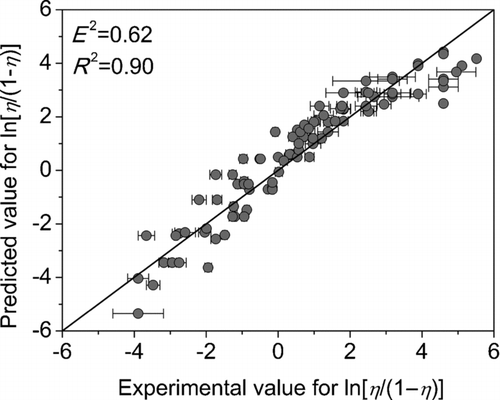
shows the comparison of the evaluation separation parameters for cyclone performance calculated by the present model and observed by the experiments from CitationIozia and Leith (1990). As a whole, it can be seen that the result by the present model has a good agreement with the experiment with the MSE of 0.62 and the DOC of 0.90, suggesting that it can provide an accurate and stable prediction performance.
4.2. Model Validation and Comparison
In order to evaluate the availability and usability of the new model, the separation efficiency curves for different cyclones are computed and compared with the experimental data as well as the classical theories in the present work. These cyclones, investigated by Beeckmans and Kim (1977), Hoffmann et al. (2001) (referenced in CitationHoffmann and Stein (2007)), CitationIozia and Leith (1990), CitationDirgo and Leith (1985), CitationZhao (2005), and CitationObermair and Staudinger (2001), include different scales which configured with the different geometrical dimensions and operated in different work conditions. Specifically, the diameter of the cyclones ranges from 0.152 to 0.40 m and the inlet velocity ranges from 10 to 20.18 m/s, as shown in . Besides the present model, other representative cyclone separation theories are employed for comparison and evaluation. These theories are developed by using different methods with simplifying assumptions, including the model of CitationBarth (1956), CitationLeith and Licht (1972), CitationDietz (1981), CitationMothes and Löffler (1988), CitationLi and Wang (1989), CitationIozia and Leith (1990), and CitationClift et al. (1991).
TABLE 4 Geometrical dimensions and operating conditions of cyclones compared in this work
FIG. 3 Comparison of present model with experimental data from Beeckmans and Kim (1977) and other theoretical models.
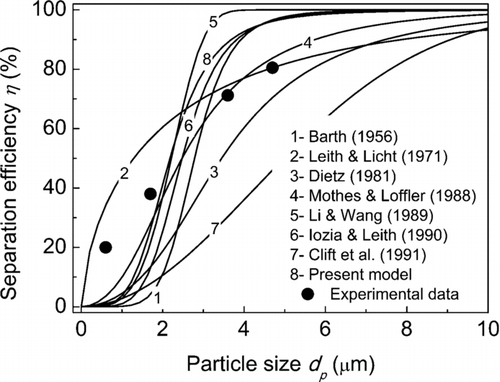
FIG. 4 Comparison of present model with experimental data from Hoffmann et al. (2001) and other theoretical models.
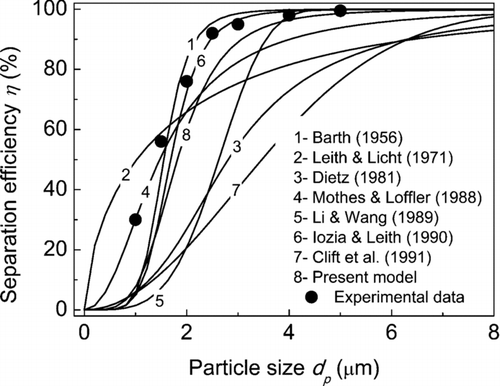
The efficiency comparison between theoretical models and experimental data is illustrated in Figures –, respectively. It can be observed that different experimental data agree better with a particular model than the other models and none of the cyclone efficiency model fit all used experimental data perfectly well. Even so, the present model still shows reasonable agreement with the experimental result. Further, the mean squared errors (MSEs) of efficiency between theoretical models and experimental data, which are defined as ![]() , are listed in . It can be found that at least in the current used experimental cases, Mothes and Löffler's model and the present model have the better performance on prediction of cyclone efficiency than other models. As one of important hybrid multi-region models,
, are listed in . It can be found that at least in the current used experimental cases, Mothes and Löffler's model and the present model have the better performance on prediction of cyclone efficiency than other models. As one of important hybrid multi-region models,
FIG. 5 Comparison of present model with experimental data from CitationIozia and Leith (1990) and other theoretical models.
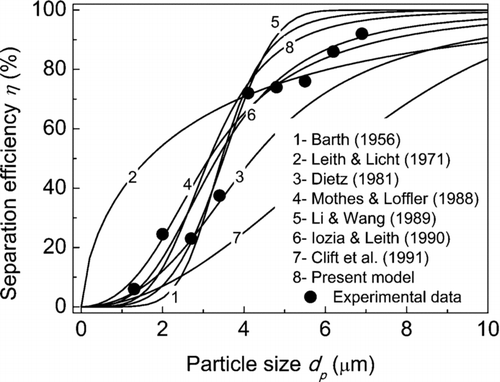
FIG. 6 Comparison of present model with experimental data from CitationDirgo and Leith (1985) and other theoretical models.
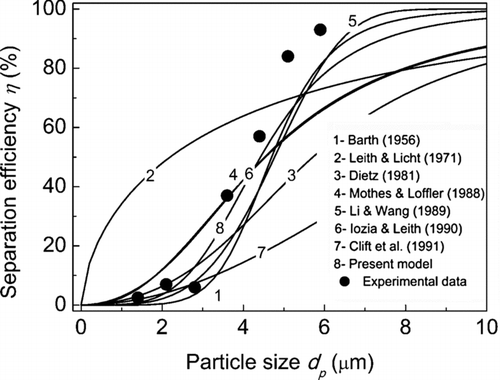
FIG. 7 Comparison of present model with experimental data from CitationZhao (2005) and other theoretical models.
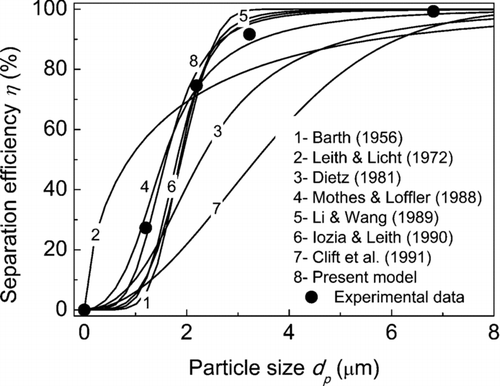
Mothes and Löffler's model used the method of modifying cyclone diameter, and considered the variation of particle concentration at axial direction in each region and the particle diffusion in different region. Comparably, Dietz's model appears to provide the low prediction on separation efficiency due to not considering the effect of particle diffusion and re-entrainment. Moreover, from it is found that Barth's model and its modified form, Iozia and Leith's model, are also show good prediction accuracy as a whole. Besides using the equilibrium-orbit assumption, Iozia and Leith obtained the characteristic parameter slope exponent in their model by fitting large number of experimental data. The relatively moderate efficiency prediction is given by Leith and Licht's model, a most popular cyclone efficiency model. This may be attributed to the rough estimation of residence time for gas flow and the assumption of completely redial back-mixing for particles. As a result, it appears to yield underestimate for larger particles and overestimate for smaller particles. The model of Clift et al., although revised the residence time for gas flow, is still unsatisfied for cyclone efficiency prediction. Because this model did not take into account the effect of conical shape on average distance particles move to the wall. With respect to Li and Wang's model, it gives a similar trends with the Barth's model, however, further investigation indicates that it is in conflict with the experimental and other theoretical result, when examining the effect of variation of cyclone outlet diameter on separation efficiency. This is reflected in and to a certain extent.
TABLE 5 Comparison of mean squared error (MSE) of efficiency between theoretical model and experimental data
FIG. 8 Comparison of present model with experimental data from CitationObermair and Staudinger (2001) and other theoretical models.
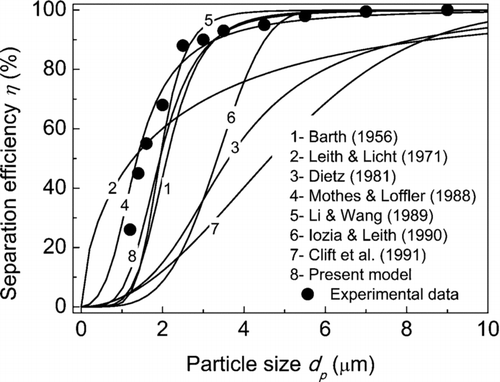
In addition, it should be emphasized that although the present model is able to predict the cyclone separation efficiency well, this model, unlike the CFD model, can not simulate the complex process of the gas-particle flow and reveal the detailed mechanism the gas-particle separation in cyclones. So far CFD model has been regarded as the most accurate theory and method in predicting cyclone efficiency compared with simplified theoretical models (CitationZhao 2006), but it requires large amounts of computational time to solve the complex Navier-Stokes equations.
5. Conclusions
In order to exactly predict the particle separation performance of cyclone separators, an empirical dimensionless model for the particle grade efficiencies is proposed using the method of stepwise multiple regression. The model indicates that the cyclone operating parameters Stk and Re as well as the geometrical parameters ab/D 2 e play the important role on cyclone separation efficiency.
The prediction result shows that for the cyclone geometries and operating conditions used to regression in the present work, the model describes the separation efficiency reasonably well. For the additional different cyclone geometry and operating conditions, the model can also provide the reasonable prediction even if it is compared with other representative cyclone separation models.
It should be noted that the work presented here is a regression model based on experimental data of separation efficiency under room temperature and pressure as well as low particle load. Therefore, additional work is still necessary to acquire a deep insight into the gas-particle flow and separation mechanisms, and adapt the model to complex industrial environment (e.g., high temperature, high pressure and high particle load), and extreme small scale cyclone where the flow state (e.g., transition or even laminar flow) and boundary layer conditions become important to separation efficiency.
This work was sponsored by Shanghai Municipal Natural Science Foundation (No. 08ZR1415100).
REFERENCES
- Barth , W. 1956 . Design and Layout of the Cyclone Separator on the Basis of New Investigations. . BWK. , 8 ( Heft 1 ) : 1 – 9 .
- Beekmans , J. M. and Kim , C. J. 1977 . Analysis of the Efficiency of Reverse Flow Cyclones. . Can. J. Chem. Engineer. , 55 : 640 – 643 .
- Boysan , F. , Ayers , W. H. and Swithenbank , J. A. 1982 . A Fundamental Mathematical Modelling Approach for Cyclone Design. . Trans. Inst. Chem. Engin. (London). , 60 : 222 – 230 .
- Büttner , H. 1999 . Dimensionless Representation of Particle Separation Characteristic of Cyclones. . J. Aerosol Sci. , 30 ( 10 ) : 1291 – 1302 .
- Chan , T. and Lippmann , M. 1977 . Particle Collection Efficiencies of Air Sampling Cyclones: An Empirical Theory. . Environ. Sci. Technol. , 11 : 377 – 382 .
- Clift , R. , Ghadiri , M. and Hoffman , A. C. 1991 . A Critique of Two Models for Cyclone Performance. . AIChE J. , 37 ( 2 ) : 285 – 289 .
- Dietz , P. W. 1981 . Collection Efficiency of Cyclone Separators. . AIChE J. , 27 ( 6 ) : 888 – 892 .
- Dirgo , J. and Leith , D. 1985 . Cyclone Collection Efficiency: Comparison of Experimental Results with Theoretical Predictions. . Aerosol Sci. Technol. , 4 ( 4 ) : 401 – 415 .
- Griffiths , W. D. and Boysan , F. 1996 . Computational Fluid Dynamics (CFD) and Empirical Modeling of a Number of Cyclone Samplers. . J. Aerosol Sci. , 27 ( 2 ) : 281 – 304 .
- Hoffmann , A. C. and Stein , L. E. 2007 . Gas Cyclones and Swirl Tubes: Principles, Design and Operation (2nd Ed.) , Berlin, Heidelberg, New York : Springer-Verlag .
- Iozia , D. L. and Leith , D. 1989 . Effect of Cyclone Dimensions on Gas Flow Pattern and Collection Efficiency. . Aerosol Sci. Technol. , 10 ( 3 ) : 491 – 500 .
- Iozia , D. L. and Leith , D. 1990 . The Logistic Function and Cyclone Fractional Efficiency. . Aerosol Sci. Technol. , 12 ( 3 ) : 598 – 606 .
- Jiao , J. and Zheng , Y. 2007 . A Multi-Region Model for Determining the Cyclone Efficiency. . Separ. and Purif. Technol. , 53 ( 3 ) : 266 – 273 .
- Kim , J. C. and Lee , K. W. 1990 . Experimental Study of Particle Collection by Small Cyclones. . Aerosol Sci. Technol. , 12 ( 4 ) : 1003 – 1015 .
- Kuo , K. Y. and Tsai , C. J. 2001 . On the Theory of Particle Cutoff Diameter and Collection Efficiency of Cyclones. . Aerosol and Air Qual. Res. , 1 ( 1 ) : 47 – 56 .
- Kim , C. H. and Lee , J. W. 2001 . A New Efficiency Model for Small Cyclones Considering the Boundary-Layer Effect. . J. Aerosol Sci. , 32 : 251 – 269 .
- Lapple , C. E. 1950 . Gravity and Centrifugal Separation. . Amer. Indus. Hyg. Assoc. Quar. , 11 ( 1 ) : 40 – 48 .
- Leith , D. and Licht , W. 1972 . The Collection Efficiency of Cyclone Type Particle Collectors: A New Theoretical Approach, in Air Pollution and Its Control. . AIChE Symposium Series. , 68 ( 126 ) : 196 – 206 .
- Li , E. and Wang , Y. 1989 . A New Theory of Cyclone Separators. . AIChE J. , 35 ( 4 ) : 666 – 669 .
- Moore , M. E. and McFarland , A. R. 1990 . Design of Stairmand-Type Sampling Cyclones. . Amer. Indust. Hyg. Assoc. J. , 51 ( 3 ) : 151 – 159 .
- Moore , M. E. and McFarland , A. R. 1993 . Performance Modeling of Single-Inlet Aerosol Sampling Cyclones. . Environ. Sci. Technol. , 27 : 1842 – 1848 .
- Mothes , H. and Löffler , F . 1988 . Prediction of Particle Removal in Cyclone Separators. . Intl. Chem. Engineer. , 23 ( 2 ) : 231 – 240 .
- Muschelknautz , E. and Trefz , M. 1992 . Pressure Drop and Separation Efficiency in Cyclones. . VDI-Heat Atlas Lj. , : 1 – 8 .
- Obermair , S. and Staudinger , G. 2001 . The Dust Outlet of a Gas Cyclone and Its Effects on Separation Efficiency. . Chem. Engineer. Technol , 24 ( 12 ) : 1259 – 1263 .
- Overcamp , T. J. and Scarlett , S. E. 1993 . Effect of Reynolds Number on the Stokes Number of Cyclones. . Aerosol Sci. Technol. , 19 ( 3 ) : 362 – 370 .
- Saltzman , B. E. and Hochstrasser , J. M. 1983 . Design and Performance of Miniature Cyclone For Respirable Aerosol Sampling. . Environ. Sci. Technol. , 17 : 418 – 424 .
- Xiang , R. , Park , S. H. and Lee , K. W. 2001 . Effects of Cone Dimension on Cyclone Performance. . J. Aerosol Sci. , 32 : 549 – 561 .
- Zhao , B. 2005 . Development of a New Method for Evaluating Cyclone Efficiency. . Chem. Engineer. Process. , 44 : 447 – 451 .
- Zhao , B. 2006 . Particle Collection Theory for Cyclone Separators: Summary and Comparison. . Particle and Particle Sys. Characteriz , 23 ( 6 ) : 484 – 488 .
- Zhou , L. X. and Soo , S. L. 1990 . Gas-solids Flow and Collection of Solids in a Cyclone Separator. . Powder Technol. , 63 : 45 – 53 .
